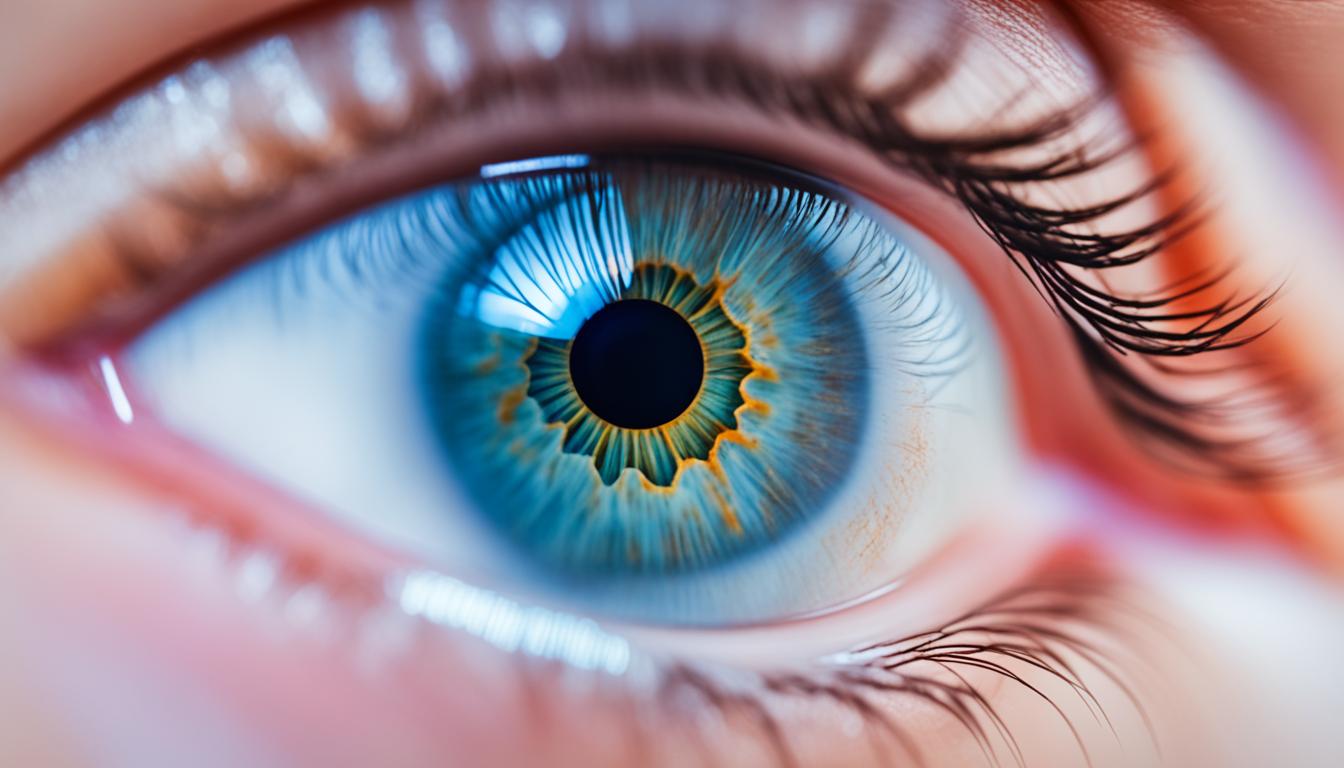Uveitis is an eye disease that causes the uveal structures to become inflamed. These structures are the iris, ciliary body, and choroid. It’s usually due to autoimmune issues. Signs are redness, vision loss, and discomfort.
To diagnose uveitis, a doctor examines your eyes closely. They might widen your pupils to see where the inflammation is. This helps figure out how bad it is and where it is in your eye.
The goal of treating uveitis is to lower inflammation and keep the disease under control. Doctors often use drugs that weaken the immune system for this. These drugs lessen the immune response, which calms down the eye’s inflammation.
Stem cell therapy is a new treatment that looks very promising for uveitis. Stem cells can turn into different cell types, including those in the immune system. This process might help reduce the eye inflammation. It gives new optimism for people with uveitis.
Key Takeaways:
- Uveitis is an inflammatory eye condition characterized by inflammation of the uveal structures.
- It can be caused by autoimmune disorders.
- Common symptoms include eye redness, vision impairment, and pain.
- Diagnosis involves a thorough clinical examination, including pupil dilation.
- Treatment options include immunosuppressive medications and stem cell therapy.
Treatment Options for Uveitis
Treating uveitis mainly uses medicines to lower swelling and manage the illness. Medicines like steroid eye drops, pills, or shots are often used. They help with inflammation for a short time.
Yet, using steroids for a long time can cause problems. Some issues are glaucoma and cataracts. For chronic uveitis, doctors might give medicines that suppress the immune system. These also help in diseases that affect the whole body. They lower immune reactions and eye inflammation.
The FDA allowed the use of Humira (adalimumab) for specific autoimmune uveitis. Humira stops the TNF-alpha protein, which helps cause the inflammation in uveitis.
Comparison of Treatment Options for Uveitis
| Medication | Administration | Side Effects | Efficacy |
|---|---|---|---|
| Steroid drugs | Topical eye drops, pills, or injections | Glaucoma, cataracts | Short-term relief |
| Immunosuppressants | Systemic administration (pills, injections) | Increased risk of infections | Long-term disease remission |
| Humira | Subcutaneous injections | Injection site reactions, increased risk of infections | Effective for certain types of autoimmune uveitis |
The choice of uveitis treatment depends on many factors. These include how serious the condition is, if someone has autoimmune diseases, and their general health. A doctor will look at these to recommend the best treatment for each person.
Prevalence and Impact of Uveitis
Uveitis is quite common worldwide and affects people a lot. Its impact on eyesight is huge. It happens in 20-50 out of 100,000 people a year.
Uveitis makes vision worse by causing macular edema and cataracts. It can also hurt the optic nerve. This leads to serious vision problems and lowers quality of life.
Uveitis is a big part of why some people go blind. It causes 10-15% of all blindness. In places like China, between 4-10% of people who get it end up blind. This shows how serious it is for global eye health.
Uveitis is the third biggest reason for preventable blindness. Catching it early and treating it can save people’s eyesight. It’s important to act fast to stop it from causing more harm.
To fight uveitis, making people more aware is crucial. Regular eye exams and easy access to eye doctors are also very important. Doing this can stop many people from going blind because of uveitis.
Prevalence and Impact of Uveitis – Key Points:
- Uveitis is a common ocular disease globally, with an incidence of 20-50 cases per 100,000 people.
- Prevalence rates of uveitis range from 100-150 cases per 100,000 people.
- Complications of uveitis, including macular edema, optic nerve edema, and cataracts, contribute to visual decline.
- Uveitis accounts for 10-15% of global blindness cases, with higher rates in specific regions like China.
- As the third leading cause of preventable blindness, uveitis necessitates early diagnosis and effective treatment.
- Increasing awareness, promoting regular eye examinations, and ensuring access to specialized care are crucial in reducing uveitis-related complications.
| Statistic | Value |
|---|---|
| Incidence of Uveitis | 20-50 cases per 100,000 people |
| Prevalence of Uveitis | 100-150 cases per 100,000 people |
| Contribution to Global Blindness | 10-15% of blindness cases |
| Blindness Due to Uveitis in China | 4-10% of uveitis patients |
| Rank in Preventable Blindness | Third leading cause |
Conclusion
Uveitis is a serious eye disease that causes inflammation in certain parts of the eye. This disease is linked to problems with the body’s immune system. If not treated, it can harm how well you see. Luckily, there are ways to treat it and keep the eyes healthy.
The main way to treat uveitis now is with special medicines. These medicines, like steroids and immunosuppressants, work to lower the inflammation. But there is also a new treatment that is showing a lot of hope. It’s called stem cell therapy. Stem cells can become different types of cells, offering new ways to manage uveitis.
Getting diagnosed early, using the right treatments, and seeing a doctor who specializes in eye disease are key. They can help make sure people with uveitis keep as much of their sight as possible. Also, as we learn more and find new treatments, like stem cell therapy, the future looks hopeful for managing uveitis.

